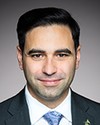Thank you and good afternoon, Chair, and committee members. It is an honour to appear before you as the 10th Governor of the Bank of Canada. I look forward to working with parliamentarians over the next seven years through regular appearances before committees of the House and the Senate. These are an important part of the bank's accountability to Canadians.
Today, Senior Deputy Governor Wilkins and I are pleased to be here as part of your study of the government's response to the COVID-19 pandemic. We are particularly looking forward to your questions and feedback on the foremost concerns of Canadians at this very difficult time.
The Bank of Canada is committed to doing everything we can to help the Canadian economy recover from the enormous impact of COVID-19. Today I will talk about the bank’s four main functions and elaborate on how the bank is responding to the pandemic. Then I will say just a few words about our operations in general. After that, we will be happy to answer your questions.
Let me begin with our most visible and tangible function—our bank notes. As a central bank, we provide a public good through a universally accepted means of payment. It is the Bank of Canada’s job to provide Canadians with safe, secure, high-quality bank notes that they can use with confidence.
We know COVID-19 is changing the relationship some Canadians are having with cash, at least temporarily. About a third of Canadians say they are using banknotes less frequently during the pandemic, and we know that some retailers are asking Canadians to use electronic payments instead of cash. The bank strongly advocates that retailers accept cash for two reasons.
First, some Canadians don't have a bank account and many others have accounts that limit the number of debit transactions or subject them to fees. These are often Canadians who are particularly vulnerable economically and they depend on cash to make essential purchases. Refusing cash puts an unfair burden on Canadians who don't have the same ease of access to financial services that the rest of us take for granted.
Second, it's important to note that handling banknotes is no more risky in terms of virus transmission than touching other common surfaces. Because the banknotes are made of polymer, they can be cleaned with soap and water. During this pandemic, public health authorities have stressed to Canadians the importance of hand washing. We should all follow this advice, including those who handle cash.
The pandemic may be accelerating an established trend where Canadians are using bank notes less often relative to electronic payments. About 1 in 10 Canadians claims not to use cash at all. At the same time, the number of bank notes in circulation continues to grow, along with demand. The bank will continue to watch closely to see how the demand for cash evolves, and we will be ready to supply all the bank notes that people and businesses want to hold.
Related to these trends in banknote use, we have also been looking closely at the idea of a central bank digital currency. Earlier this year, deputy governor Tim Lane spoke about the circumstances when it might make sense for the Bank of Canada to issue its own digital currency. This includes a situation in which most Canadians stopped using banknotes. We don't believe that a digital currency is required at this time, but we are moving forward with contingency planning so that if we ever judge that we should issue a digital currency, we would be ready.
The second function I will mention is our funds management role. The bank is the fiscal agent of the government. We advise the government on strategies for its debt and cash management, and we conduct auctions for federal government bonds and treasury bills. We also provide banking services to some financial institutions, Crown corporations, other central banks and international financial institutions.
This is an important function in regular times. We help the government manage its finances in a cost-effective way, but this function has taken on added importance during the pandemic. The government's financing needs have increased at an unprecedented pace this fiscal year with the introduction of needed measures to reduce the pandemic's impact on the Canadian economy. I note that even with the record issuance, Canada's net debt-to-GDP ratio remains the lowest among G7 countries.
Because interest rates on Government of Canada debt serve as the benchmark for many financial markets, it is imperative to keep the government bond markets working well. To do this, the bank has implemented a number of extraordinary measures, and this brings me to our financial system function.
Our third function is the promotion of a stable and efficient financial system. The bank is unique in that it has a system-wide perspective on the stability and efficiency of the system. We bring this perspective to our work with federal and provincial partners to make sure the financial system is working well to support the real economy.
Credit is the lifeblood of modern market-based economies. In a crisis, central banks have a critical imperative to provide the liquidity the financial system needs to keep credit flowing. This traditional role of central banks goes back hundreds of years. In the 1800s, British journalist Walter Bagehot famously said that in a crisis a central bank should lend freely, at a penalty rate, against good collateral. What he meant was that a central bank should always be ready to make sure the financial system has sufficient cash or liquidity during times of stress so that it can help the economy weather the storm, rather than becoming a headwind itself.
The onset of the COVID-19 pandemic was hugely disruptive to many vital financial markets. Liquidity disappeared from markets, as participants sought to protect their own liquidity by increasing their cash holdings. Amid the uncertainty, credit markets began to seize up. The bank’s priority from March to May was to restore proper functioning to financial markets so that Canadian households, businesses and governments could access credit to withstand the crisis. This should also help set the stage for recovery.
Under the leadership of my predecessor, Governor Poloz, as well as Senior Deputy Governor Wilkins, the bank did an outstanding job restoring the smooth functioning of key markets, ensuring ample funding and market liquidity.
The bank revived some emergency programs used during the global financial crisis over a decade ago, and it brought into operation several new measures with remarkable speed and precision. We are pleased to report that demand for liquidity is returning to normal levels and market functioning has improved considerably. The bank, therefore, has scaled back the frequency of some operations because financial market participants are not using them. We stand ready to ramp up these programs again if they are needed.
Finally, let me say a few words about the conduct of monetary policy. Our framework is set out in the inflation targeting agreement established with the government and renewed every five years. The agreement sends an important signal that the democratically elected government and the bank are agreed on our policy goal while giving the bank the operational independence to pursue that goal. This independence is crucial both in normal times and in crisis times.
Through this pandemic, the Bank of Canada, the government and financial Crown corporations and agencies have all been working closely and collaboratively to stabilize the financial system, keep credit flowing and support the economy. The bank's actions are designed to complement the government's fiscal efforts. At the same time, we are cognizant of each other's mandates, and the government has made it clear that it fully respects our independence.
As governor, I will protect the bank's ability to act independently, consistent with our mandate, because that independence is critical to the confidence that Canadians place in us, the credibility of our inflation target and our capacity to achieve it.
Under our policy framework, our mandate is to provide low, stable and predictable inflation. That's the best contribution we can make to the country's economic and financial welfare. Achieving our inflation goals lays the foundation for sustainable economic growth, and keeping inflation close to its target means the economy is running close to capacity with full employment.
Our inflation target takes on added importance during a time of crisis. As the bank moves into uncharted waters using tools it has not deployed before, the inflation target remains our beacon. Our monetary policy actions are anchored in the goal of bringing inflation back to target by helping the economy return to its potential capacity and full employment.
COVID-19 and the measures to contain it represent an economic shock of unprecedented size and scope to our economy. By April more than 3 million Canadians had lost their jobs and another 3.4 million were working fewer than half their regular hours.
With containment measures starting to lift in some parts of the country, we saw a resumption of job growth at a national level in May. We expect this to accelerate as the economy continues to reopen, but we have a long way to go and not all the jobs are going to come back. Important fiscal efforts are keeping as many Canadians as possible attached to their jobs and helping households and companies make it through the crisis. These efforts are supporting Canadians now and will position the economy for recovery.
In our latest interest rate announcement, we said we expect economic growth to resume in the third quarter. With market function improved and containment restrictions easing, the bank's focus will shift to supporting the resumption of growth in output and employment.
The July monetary policy report will provide our updated assessment of the outlook for output and inflation. Given the unknown course of the pandemic, I expect this will be more of a scenario than a forecast, and it will also include a discussion of key risks.
While our monetary policy will continue to be grounded in our inflation-targeting framework, we acknowledge that the consumer price index isn’t currently giving an accurate picture of inflation for many Canadians.
Buying patterns and prices have changed drastically. Bank staff have been working with Statistics Canada to better understand the implications of these changes in buying patterns.
The bank has acted decisively by bringing the policy interest rate to its effective lower bound of 25 basis points. We have also begun large-scale asset purchases. In so doing, we are using our balance sheet to keep core funding markets working well and to deliver monetary stimulus to support the economic recovery. We have committed to continuing to purchase Government of Canada bonds until the recovery is well under way. Any further policy actions will be calibrated to provide the necessary degree of monetary accommodation required to achieve our inflation target.
Let me conclude with a few words about the bank's operations.
Currently, the vast majority of the bank staff are working from home. This is a testament to the flexibility and resilience of the bank's systems and its people. A handful of essential workers are on site, including security staff, IT staff, traders, bank operations colleagues at our head office, as well as staff at our backup site in Calgary and our regional operations centres. Bank staff are delivering for Canadians, and I am confident that this will continue.
The bank has a long tradition of ensuring accountability and transparency, and we are committed to building on this. We will maintain our momentum in a couple of areas. First, we recognize that all Canadians have a right to understand what their central bank is doing and why. This is even more important today as we undertake unprecedented policy actions. We will be transparent about the results of our asset purchase programs, and we will continue to promote the use of plain language to help demystify our operations for interested Canadians.
Second, we have stepped up efforts to engage with a wide variety of stakeholder groups beyond our traditional partners.
Our goals are to reach Canadians directly and increase public knowledge of and participation in our activities in order to broaden understanding of our work and to build trust.
A number of activities to engage the public are upcoming or already underway. These include an online campaign to involve the public in the 2021 renewal of our inflation-targeting framework.
We also just concluded a campaign inviting the public to nominate an iconic Canadian to be featured on the next five-dollar note.
Let me stop there, Chair.














